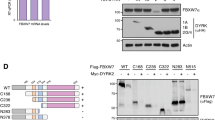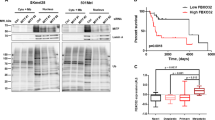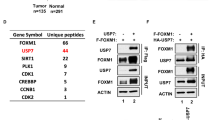Abstract
The inhibitor of growth family member 3 (ING3) has been shown to modulate transcription, cell cycle control and apoptosis. We previously reported that nuclear ING3 expression was remarkably reduced in melanomas, which correlated with a poorer patient survival, suggesting that decreased ING3 expression may be associated with melanoma progression. However, the mechanism of diminished ING3 expression in melanoma is not clear. Here we show that ING3 level was decreased in metastatic melanoma cells because of a rapid degradation. Furthermore, we showed that ING3 undergoes degradation through the ubiquitin–proteasome pathway. ING3 physically interacts with subunits of E3 ligase Skp1-Cullin-F-box protein complex (SCF complex). Knockdown of F-box protein S-phase kinase-associated protein 2 (Skp2) reduces the ubiquitination of ING3 and significantly stabilizes ING3 in melanoma cells. In addition, lysine 96 residue is essential for ING3 ubiquitination as its mutation to arginine dramatically abrogated ING3 degradation. Disruption of ING3 degradation stimulated ING3-induced G1 cell-cycle arrest and enhanced ultraviolet-induced apoptosis. Taken together, our data show that ING3 is degraded by the ubiquitin–proteasome pathway through the SCFSkp2 complex and interruption of ING3 degradation enhances the tumor-suppressive function of ING3, which provides a potential cancer therapeutic approach by interfering ING3 degradation.
This is a preview of subscription content, access via your institution
Access options
Subscribe to this journal
Receive 50 print issues and online access
$259.00 per year
only $5.18 per issue
Buy this article
- Purchase on Springer Link
- Instant access to full article PDF
Prices may be subject to local taxes which are calculated during checkout






Similar content being viewed by others
References
Ang XL, Wade Harper J . (2005). SCF-mediated protein degradation and cell cycle control. Oncogene 24: 2860–2870.
Asher G, Tsvetkov P, Kahana C, Shaul Y . (2005). A mechanism of ubiquitin-independent proteasomal degradation of the tumor suppressors p53 and p73. Genes Dev 19: 316–321.
Ben-Shahar S, Komlosh A, Nadav E, Shaked I, Ziv T, Admon A et al. (1999). 26 S proteasome-mediated production of an authentic major histocompatibility class I-restricted epitope from an intact protein substrate. J Biol Chem 274: 21963–21972.
Burger AM, Seth AK . (2004). The ubiquitin-mediated protein degradation pathway in cancer: therapeutic implications. Eur J Cancer 40: 2217–2229.
Chiappetta G, De Marco C, Quintiero A, Califano D, Gherardi S, Malanga D et al. (2007). Overexpression of the S-phase kinase-associated protein 2 in thyroid cancer. Endocr Relat Cancer 14: 405–420.
Ciechanover A, Ben-Saadon R . (2004). N-terminal ubiquitination: more protein substrates join in. Trends Cell Biol 14: 103–106.
Doyon Y, Selleck W, Lane WS, Tan S, Cote J . (2004). Structural and functional conservation of the NuA4 histone acetyltransferase complex from yeast to humans. Mol Cell Biol 24: 1884–1896.
Fadlelmola FM, Zhou M, de Leeuw RJ, Dosanjh NS, Harmer K, Huntsman D et al. (2008). Sub-megabase resolution tiling (SMRT) array-based comparative genomic hybridization profiling reveals novel gains and losses of chromosomal regions in Hodgkin lymphoma and anaplastic large cell lymphoma cell lines. Mol Cancer 7: 2.
Frescas D, Pagano M . (2008). Deregulated proteolysis by the F-box proteins SKP2 and beta-TrCP: tipping the scales of cancer. Nat Rev Cancer 8: 438–449.
Garate M, Campos EI, Bush JA, Xiao H, Li G . (2007). Phosphorylation of the tumor suppressor p33(ING1b) at Ser-126 influences its protein stability and proliferation of melanoma cells. FASEB J 21: 3705–3716.
Garate M, Wong RP, Campos EI, Wang Y, Li G . (2008). NAD(P)H quinone oxidoreductase 1 inhibits the proteasomal degradation of the tumour suppressor p33(ING1b). EMBO Rep 9: 576–581.
Goldberg AL . (2007). Functions of the proteasome: from protein degradation and immune surveillance to cancer therapy. Biochem Soc Trans 35: 12–17.
Gong W, Russell M, Suzuki K, Riabowol K . (2006). Subcellular targeting of p33ING1b by phosphorylation-dependent 14-3-3 binding regulates p21WAF1 expression. Mol Cell Biol 26: 2947–2954.
Gunduz M, Beder LB, Gunduz E, Nagatsuka H, Fukushima K, Pehlivan D et al. (2008). Downregulation of ING3 mRNA expression predicts poor prognosis in head and neck cancer. Cancer Sci 99: 531–538.
Gunduz M, Ouchida M, Fukushima K, Ito S, Jitsumori Y, Nakashima T et al. (2002). Allelic loss and reduced expression of the ING3, a candidate tumor suppressor gene at 7q31, in human head and neck cancers. Oncogene 21: 4462–4470.
He GH, Helbing CC, Wagner MJ, Sensen CW, Riabowol K . (2005). Phylogenetic analysis of the ING family of PHD finger proteins. Mol Biol Evol 22: 104–116.
Hershko DD . (2008). Oncogenic properties and prognostic implications of the ubiquitin ligase Skp2 in cancer. Cancer 112: 1415–1424.
Inoue T, Geyer RK, Howard D, Yu ZK, Maki CG . (2001). MDM2 can promote the ubiquitination, nuclear export, and degradation of p53 in the absence of direct binding. J Biol Chem 276: 45255–45260.
Katagiri Y, Hozumi Y, Kondo S . (2006). Knockdown of Skp2 by siRNA inhibits melanoma cell growth in vitro and in vivo. J Dermatol Sci 42: 215–224.
Kuo ML, den Besten W, Bertwistle D, Roussel MF, Sherr CJ . (2004). N-terminal polyubiquitination and degradation of the Arf tumor suppressor. Genes Dev 18: 1862–1874.
Li J, Martinka M, Li G . (2008). Role of ING4 in human melanoma cell migration, invasion, and patient survival. Carcinogenesis 29: 1373–1379.
Li Q, Murphy M, Ross J, Sheehan C, Carlson JA . (2004). Skp2 and p27kip1 expression in melanocytic nevi and melanoma: an inverse relationship. J Cutan Pathol 31: 633–642.
Lu F, Dai DL, Martinka M, Ho V, Li G . (2006). Nuclear ING2 expression is reduced in human cutaneous melanomas. Br J Cancer 95: 80–86.
Mani A, Gelmann EP . (2005). The ubiquitin–proteasome pathway and its role in cancer. J Clin Oncol 23: 4776–4789.
Masuda TA, Inoue H, Sonoda H, Mine S, Yoshikawa Y, Nakayama K et al. (2002). Clinical and biological significance of S-phase kinase-associated protein 2 (Skp2) gene expression in gastric carcinoma: modulation of malignant phenotype by Skp2 overexpression, possibly via p27 proteolysis. Cancer Res 62: 3819–3825.
Nagashima M, Shiseki M, Pedeux RM, Okamura S, Kitahama-Shiseki M, Miura K et al. (2003). A novel PHD-finger motif protein, p47ING3, modulates p53-mediated transcription, cell cycle control, and apoptosis. Oncogene 22: 343–350.
Nalepa G, Rolfe M, Harper JW . (2006). Drug discovery in the ubiquitin–proteasome system. Nat Rev Drug Discov 5: 596–613.
Nandi D, Tahiliani P, Kumar A, Chandu D . (2006). The ubiquitin–proteasome system. J Biosci 31: 137–155.
Newton K, Vucic D . (2007). Ubiquitin ligases in cancer: ushers for degradation. Cancer Invest 25: 502–513.
Ng KC, Campos EI, Martinka M, Li G . (2004). XAF1 expression is significantly reduced in human melanoma. J Invest Dermatol 123: 1127–1134.
Nouman GS, Anderson JJ, Mathers ME, Leonard N, Crosier S, Lunec J et al. (2002). Nuclear to cytoplasmic compartment shift of the p33ING1b tumour suppressor protein is associated with malignancy in melanocytic lesions. Histopathology 40: 360–366.
Schwechheimer C, Calderon Villalobos LI . (2004). Cullin-containing E3 ubiquitin ligases in plant development. Curr Opin Plant Biol 7: 677–686.
Shah IM, Di Napoli M . (2007). The ubiquitin–proteasome system and proteasome inhibitors in central nervous system diseases. Cardiovasc Hematol Disord Drug Targets 7: 250–273.
Sonoda H, Inoue H, Ogawa K, Utsunomiya T, Masuda TA, Mori M . (2006). Significance of skp2 expression in primary breast cancer. Clin Cancer Res 12: 1215–1220.
Sumimoto H, Hirata K, Yamagata S, Miyoshi H, Miyagishi M, Taira K et al. (2006). Effective inhibition of cell growth and invasion of melanoma by combined suppression of BRAF (V599E) and Skp2 with lentiviral RNAi. Int J Cancer 118: 472–476.
Tsai KW, Tseng HC, Lin WC . (2008). Two wobble-splicing events affect ING4 protein subnuclear localization and degradation. Exp Cell Res 314: 3130–3141.
von Mikecz A . (2006). The nuclear ubiquitin–proteasome system. J Cell Sci 119: 1977–1984.
Wang Y, Dai DL, Martinka M, Li G . (2007). Prognostic significance of nuclear ING3 expression in human cutaneous melanoma. Clin Cancer Res 13: 4111–4116.
Wang Y, Li G . (2006). ING3 promotes UV-induced apoptosis via Fas/caspase-8 pathway in melanoma cells. J Biol Chem 281: 11887–11893.
Woenckhaus C, Maile S, Uffmann S, Bansemir M, Dittberner T, Poetsch M et al. (2005). Expression of Skp2 and p27KIP1 in naevi and malignant melanoma of the skin and its relation to clinical outcome. Histol Histopathol 20: 501–508.
Yang G, Ayala G, De Marzo A, Tian W, Frolov A, Wheeler TM et al. (2002). Elevated Skp2 protein expression in human prostate cancer: association with loss of the cyclin-dependent kinase inhibitor p27 and PTEN and with reduced recurrence-free survival. Clin Cancer Res 8: 3419–3426.
Yokoi S, Yasui K, Mori M, Iizasa T, Fujisawa T, Inazawa J . (2004). Amplification and overexpression of SKP2 are associated with metastasis of non-small-cell lung cancers to lymph nodes. Am J Pathol 165: 175–180.
Zetter BR, Mangold U . (2005). Ubiquitin-independent degradation and its implication in cancer. Future Oncol 1: 567–570.
Acknowledgements
We gratefully thank Drs HR Byers, AP Albino, H Silver, R Zhang, M Pagano, S Sun and J Hsieh for kindly providing the materials. This study was supported by Cancer Research Society, the Canadian Institutes of Health Research (MOP-93810) and the Canadian Dermatology Foundation (GL). GC is a recipient of Postdoctoral Trainee Award from Michael Smith Foundation for Health Research. YW is a recipient of Roman M Babicki Fellowship from the University of British Columbia and a research fellow of the Terry Fox Foundation through an award from the National Cancer Institute of Canada.
Author information
Authors and Affiliations
Corresponding author
Additional information
Supplementary Information accompanies the paper on the Oncogene website (http://www.nature.com/onc)
Supplementary information
Rights and permissions
About this article
Cite this article
Chen, G., Wang, Y., Garate, M. et al. The tumor suppressor ING3 is degraded by SCFSkp2-mediated ubiquitin–proteasome system. Oncogene 29, 1498–1508 (2010). https://doi.org/10.1038/onc.2009.424
Received:
Revised:
Accepted:
Published:
Issue Date:
DOI: https://doi.org/10.1038/onc.2009.424
Keywords
This article is cited by
-
Skp2-mediated MLKL degradation confers cisplatin-resistant in non-small cell lung cancer cells
Communications Biology (2023)
-
Human ex vivo prostate tissue model system identifies ING3 as an oncoprotein
British Journal of Cancer (2018)
-
E3 ubiquitin ligase Nedd4 inhibits AP-1 activity and TNF-α production through targeting p38α for polyubiquitination and subsequent degradation
Scientific Reports (2017)
-
INGs are potential drug targets for cancer
Journal of Cancer Research and Clinical Oncology (2017)
-
A phase I study of the investigational NEDD8-activating enzyme inhibitor pevonedistat (TAK-924/MLN4924) in patients with metastatic melanoma
Investigational New Drugs (2016)



